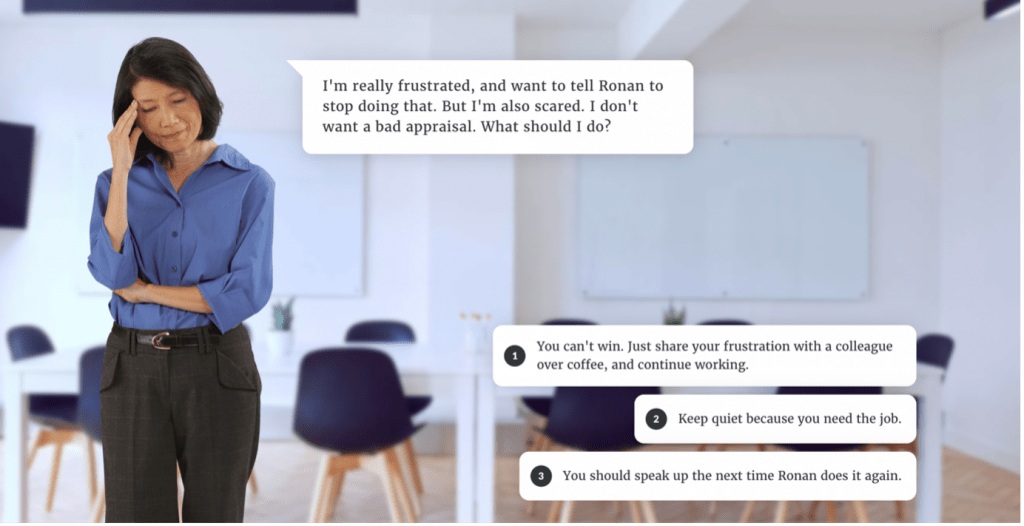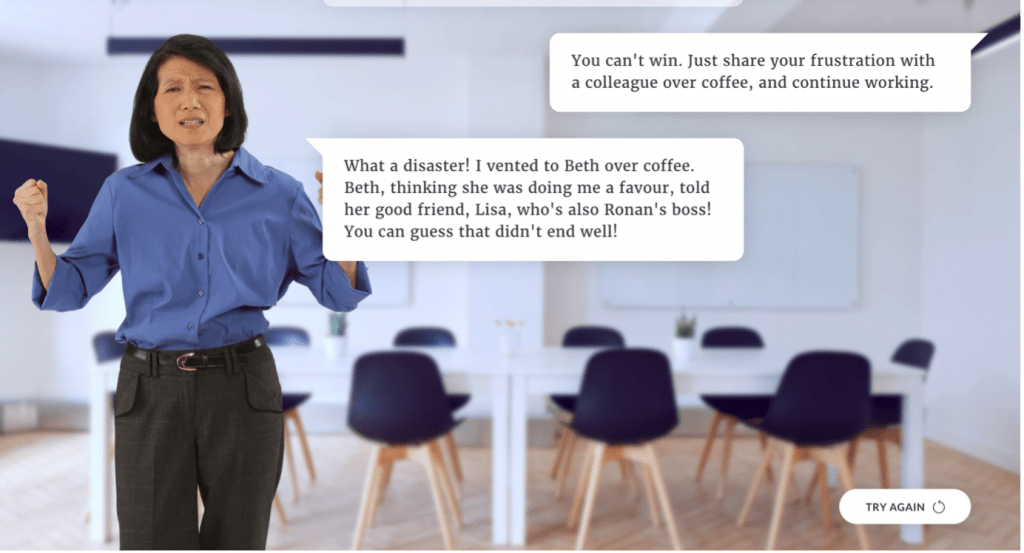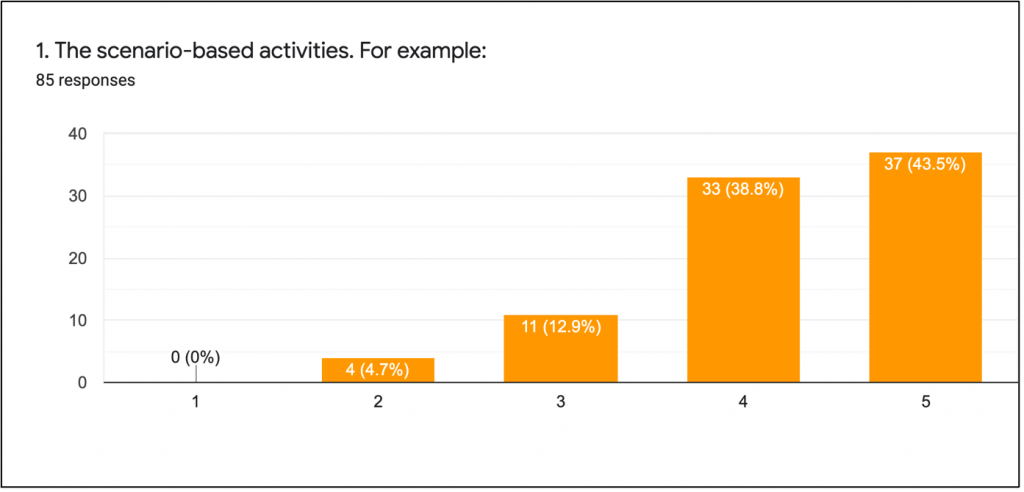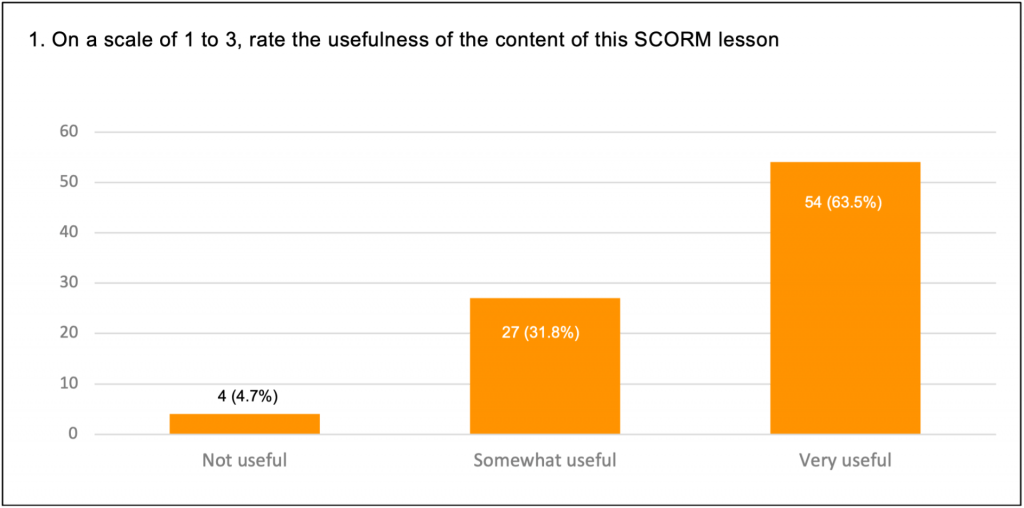“Choose-your-own-adventure”: Engaging e-lessons with interactive scenarios
by Anita Toh
A major challenge in flipped lessons is getting the students to complete the requisite pre-class work prior to the in-class sessions. Most pre-class work involve students reading texts, viewing powerpoint slides, watching videos and then completing a task sheet or quiz, or participating in a forum discussion.
When I was designing a flipped lesson on assertive communication skills, I did not want the students doing any of these. I wanted to be able to ask them a question, have them select an answer, and provide them with immediate feedback on their responses. I wanted to create a “choose your own adventure” type of experience for them. (The “Choose you own adventure” books are a series of books popular in the 1990s where readers take the role of the protagonist in the stories and make decisions that take them to different outcomes in the story.)
Therefore, I experimented with interactive scenarios. The pedagogical basis for interactive scenarios is scenario-based learning (SBL).
Scenario-based learning (SBL)
SBL is based on Lave and Wenger’s situated learning theory, which holds that learning needs to occur in authentic contexts, in situations where the knowledge is to be used (Errington, 2005). SBL involves the use of scenarios or stories that enable students to explore decision-making, critical thinking and problem-solving in real-world situations without the risk of real-world consequences. These scenarios may be presented orally, in writing or via interactive videos and software applications.
In e-lessons, SBL commonly utilizes interactive scenarios that take students through a story in which the protagonist is experiencing a problem. Students are presented with several options. They have to select the course of action they think the protagonist should take and see the consequences of their selection. Students may replay the interactive scenario multiple times to explore the outcome of different courses of action.
The following is an example of one of the interactive scenarios I created for the assertive communication skills e-lesson.
 Figure 1. Interactive scenario presenting a problem with 3 choices
Figure 1. Interactive scenario presenting a problem with 3 choices
 Figure 2. The outcome of selecting one of the choices
Figure 2. The outcome of selecting one of the choices
These interactive scenarios were created using Articulate Rise, an online content authoring tool. The lesson was exported as a SCORM (Shareable Content Object Reference Model) package and uploaded to the university’s learning management system, LumiNUS. Students access the e-lesson (known to students as a SCORM lesson) via LumiNUS.
Students’ reactions to the interactive scenarios
105 students were invited to complete an online survey after completing the SCORM lesson on assertive communication skills. 85 responses (80.95%) were collected.
Students were asked to rate the interactive scenarios on a scale of 1 (Not engaging) to 5 (Very engaging). The figure below shows that 82.3% of the respondents indicated that they found the interactive scenarios “engaging” and “very engaging”.
 Figure 3. Students’ ratings of the interactive scenarios
Figure 3. Students’ ratings of the interactive scenarios
Students were also asked to rate the usefulness of the content of the SCORM lesson. Most of the students (95.3%) found the lesson “somewhat useful” and “very useful”.
Figure 4. Students’ ratings of the relevance of the content of the assertive communication skills SCORM lesson
The students were asked to comment on the interactive scenarios. Most comments were positive and were related to the pedagogical and engagement value of the lesson.
The following are some of their comments on the interactive scenarios:
| Comments about the pedagogical value of the interactive scenarios |
|
| Comments about the engagement value of the interactive scenario |
|
Figure 5. Students’ comments about the interactive scenarios
While it is encouraging to see that many students appreciated the interactivity and pedagogical value of the interactive scenarios, some comments highlighted important areas for consideration and improvement.
|
Figure 6. Students’ comments about the branching scenarios
Discussion
The first two comments in Figure 6 above show that for skills-based lessons like assertive communication skills, the e-lesson is most effective if it is followed by in-class activities that require students to apply what they have learned from the e-lesson. As Karanicolas et al. (2016) assert, the purpose of pre-class activities is to introduce students to fundamental concepts; the purpose of in-class activities is to advance these concepts further and develop higher order skills. In this flipped lesson on assertive communication skills, the in-class component comprises group discussions and roleplays of various scenarios where the students have to apply and adapt assertiveness strategies learned from the e-lesson.
The third comment in Figure 6 is a reminder that while interactive scenarios may be fun and engaging, what is most important is whether it is the best tool to convey the learning content. Sometimes, it may make more sense to quickly convey the information in just one or two lines of text.
Conclusion
Engaging e-learning content improves the chances of learners achieving the learning outcomes. Lee, Park and Davis (2018) note that many researchers have found that learner engagement is a pre-requisite for academic success. My attempt to make the pre-class learning materials engaging through the use of interactive scenarios appears to have been successful.
However, it must be noted that these interactive scenarios are only a vehicle for delivering the lesson content. At the heart of any engaging e-lesson must lie content that is useful and relevant to students. We must not forget that the emphasis of e-learning should not be on its appeal, but instead, on its effectiveness for learning (Mishra & Koehler, 2006). At the time of writing this article, a study is underway to examine the learning outcomes of the SCORM lessons.
References
Errington, E. (2011). As close as it gets: Developing professional identity through the potential of scenario-based learning. Surrey Centre for Excellence in Professional Training and Education.
Karanicolas, S., Loveys, B., Riggs, K., McGrice, H., Snelling, C., Winning, T., & Kemp, A. The Rise of the Flip: Successfully engaging students in pre-class activities through the use of technology and a flipped classroom design template. In 33rd International Conference of Innovation, Practice and Research in the Use of Educational Technologies in Tertiary Education, 312–317.
Lee, J., Park, T., & Davis, R. O. (2018). What affects learner engagement in flipped learning and what predicts its outcomes? British Journal of Educational Technology. https://doi.org/10.1111/bjet.12717
Mishra, P., & Koehler, M. J. (2006). Technological pedagogical content knowledge: A framework for teacher knowledge. Teachers college record, 108(6), 1017-1054.

